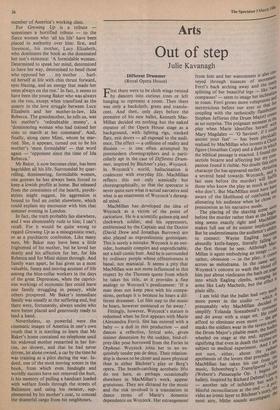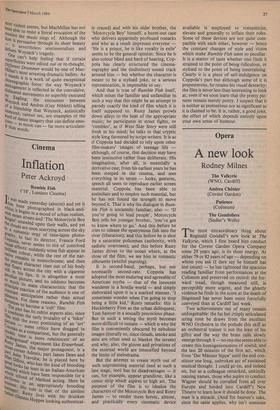Arts
Out of step
Julie Kavanagh
Different Drummer (Royal Opera House) Different Drummer (Royal Opera House) Vfirst there were to be cloth wings twisted
by dancers into curious trees or left hanging to represent a room. Then there was only a backcloth, green and translu- cent. And then, only days before the premiere of his new ballet, Kenneth Mac- Millan decided on nothing but the naked expanse of the Opera House stage as a background, with lighting rigs, stacked flats, exit doors — all exposed to the audi- ence. The effect — a collision of reality and illusion — is one often attempted by postmodern choreographers and is parti- cularly apt in the case of Different Drum- mer, inspired by Btichner's play, Woyzeck. In Woyzeck's world, hallucination is coalescent with everyday life. MacMillan reflects this not only scenically but choreographically, so that the spectator is never quite sure what is actual narrative and what is an enactment of Woyzeck's derang- ed mind.
MacMillan has developed the idea of Woyzeck as a victim of the point of caricature. He is a scientific guinea-pig and clockwork soldier, and his oppressors, emblemised by the Captain and the Doctor (David Drew and Jonathan Burrows) are also played as expressionistic grotesques. This is surely a mistake. Woyzeck is an out- sider, humanly complex and unpredictable, not a half-comic butt. And he is surrounded by ordinary people whose offensiveness is banal, not maniacal. It seems a pity that MacMillan was not more influenced in this respect by the Thoreau quote from which he takes his title, as it provides a fine analogy to Woyzeck's predicament: 'If a man does not keep pace with his compa- nions, perhaps it is because he hears a dif- ferent drummer. Let him step to the music he hears, however measured or far away.'
Fittingly, however, Woyzeck's stature is redeemed when he first appears with Marie (Alessandra Ferri). She has entered with a baby — a doll in this production — and dances a reflective, lyrical solo, given sinister dimension by the sudden, bird-of- prey-like pose borrowed from the Furies in Orpheus. Woyzeck joins her in an ex- quisitely tender pas de deux. Their relation- ship is shown to be closer and more physical than in either Biichner's play or Berg's opera. The breath-catching acrobatic lifts do not here, as perhaps occasionally elsewhere in MacMillan's work, appear gratuitous. They are dictated by the music and the risk involved is a translation in dance terms of Marie's domestic dependence on Woyzeck. Her estrangement from him and her wantonness is also con- veyed through nuances of movement Ferri's back arching away and the ste% splitting of her beautiful legs — like "1'. compasses' — seem to image her inclinatil to roam. Ferri grows more voluptuous her meretricious before our eyes so that :it coupling with the technically flambnY“;, Stephen Jefferies (the Drum Major) at as no surprise. The poignant moment in play when Marie identifies herself old Mary Magdalen — '0 Saviour, if I ly anoint your feet' — has been phYsiew realised by MacMillan who invents a Christi figure (Jonathan Cope) and a duet in Which the biblical passage is enacted. I found this the bizarre and affecting but ttlY c0',; panion found it risible. No doubt this Tuning character (he has appeared earlier, 00,461 a severed head towards Woyzeck, an"ffic last seen before the murder) Will ba- se those who know the play as much as i..1.1,e° 0 who don't. But MacMillan must have been aware of the likelihood of confusing a" alienating his audience when he chose e". pressionism as his narrative mode. on The placing of the shaving scene soon The the murder rather than at the hegat; ning seems exactly right and Maclviiins. makes full use of its sinister implicatui°0y But he underestimates the audience's au' "es to connect: Wayne Eagling hec, ron absurdly knife-happy, literally tall'Itac- the first throat he sees. Although '-or, Milian is again embodying an image „dies rather, obsession — in the play, it twee, across as melodrama. In the Sallie :-01:1. Woyzeck's concern to wash the hloci"igge him just about vindicates the bath on his into which Eagling climbs, wringingt is parlamins sliiklley,Lady. Macbeth, but the effec* „nob I am told that the ballet had verY :II is more power in the studio — to presumably why MacMillan decided to Yolanda Sonnabend's cnst'aid and do away with a stage set. Kee gas afford to eliminate even more — masks the soldiers wear in the tavern Scene, ies the Drum Major's pliable mace, the b,.,otlY wheeled on stage at the end, aPPa'" are signifying that even in death the victilhis 0 subject to medical experiment. And dont not sure, either, about the ,!tilis. apotheosis of the lovers that preeeue' the MacMillan has taken his cue frnillhfight (Webern's Passacaglia Op. tieet;r: 's °oif: music, Schoenberg's Transfif ballet). Inspired by Richard Debater 51 a another tale of infidelity but wit..40,. blissful reconciliation at the end -- vole vides an ironic layer to Biichner's story' ire most airy, blithe sounds accompany most violent scenes, but MacMillan has not been able to resist a literal evocation of the reunion the music sings of. Although the duet is persuasive through its sheer beauty
It nevertheless sentimentalises and defuses Woyzeck's tragedy. °ne can't help feeling that if certain superfluities were edited out or re-thought,
MDifferent Drummer would be one of Mac- illan's most arresting dramatic ballets. As it stands it is a work of quite exceptional ecilloteographic force: the way Woyzeck's P.aagement is reflected in the convulsive, 'Isiocated movements so superbly executed Eagling; the encounter between F4. °Yzeck and Andres (Guy Niblett) telling a friendship that Woyzeck, autistically ilf(!limured, cannot see, are examples of the tiind of dance imagery that can define emo- , t3ris as music can — far more articulate- ly than wos.











































 Previous page
Previous page